Review of Power Electronics Technologies in the Integration of Renewable Energy Systems
Abstract
:1. Introduction
- Conventional MPPT methodologies [25,26] are progressively giving way to AI/ML-based strategies [27,28,29]. Standardized benchmarking within different MPPT scenarios appears to be lacking, according to comparative reviews [29,30,31]. A number of studies emphasize converter design, control under grid failures, and PMSG-based wind systems [32,33]. Vehicle applications, cold starts, and hybridization with batteries or ultracapacitors are the main priorities of fuel cell research [34,35,36,37,38,39,40,41,42,43].
- Power electronics converters have failed to provide high efficiency under fluctuating or variable conditions.
- There is not much in the literature on coordinated control for multi-source hybrid systems, despite the fact that many studies prioritize single systems (PV, wind, and FC).
- The demand-side management and power flow in both directions play important roles and act as the functionalities in smart grid integration; however, many power electronics converters have not shown good compatibility over attaining these functionalities.
- Additionally, it was found that there is a need of to achieve proper coordination between the energy storage phenomenon and power converters in order to avoid reliability issues. As the smart grid is highly associated with IOT platforms, proper monitoring devices have to be installed to avoid safety issues.
- A lack of validation and real-world datasets for AI-based MPPT [28].
2. Demand of Renewable Energy Generation
2.1. RES Architecture
2.2. Demands for PV Power Generation
- Mode of constant power factor;
- Active power-reactive power mode;
- Voltage-reactive power mode;
- Mode of constant reactive power [5].
2.3. Demands for Wind Power Generation
3. Literature Survey
4. Application of Power Electronics in RES
4.1. DC-Powered Electric Network
4.2. Power System Connected to Microturbines
4.3. Grid-Integrated Solar PV Inverters
4.4. PV Power Optimizer
4.5. Power Systems Connected to Wind Turbines
4.6. Power Systems Connected to Fuel Cells
4.7. Power Systems Connected to Variable-Speed Hydro–Wind Turbines
4.8. Role of AI in Grid Integration of RESs
5. Conclusions
Author Contributions
Funding
Institutional Review Board Statement
Informed Consent Statement
Data Availability Statement
Conflicts of Interest
References
- Fache, A.; Bhat, M.G.; Troxler, T.G. Renewable Energy Policies in the USA: A Comparative Study of Selected States. Energies 2025, 18, 607. [Google Scholar] [CrossRef]
- Gopal, Y.; Kumari, A.; Panda, K.P.; Dhaked, D.K.; Arya, Y. Implementation and analysis of switched-capacitor multilevel inverters in solar photovoltaic system. Sustain. Energy Technol. Assess. 2025, 75, 104227. [Google Scholar] [CrossRef]
- Che, E.E.; Abeng, K.R.; Iweh, C.D.; Tsekouras, G.J.; Fopah-Lele, A. The Impact of Integrating Variable Renewable Energy Sources into Grid-Connected Power Systems: Challenges, Mitigation Strategies, and Prospects. Energies 2025, 18, 689. [Google Scholar] [CrossRef]
- Gu, Y.; Huang, Y.; Wu, Q.; Li, C.; Zhao, H.; Zhan, Y. Isolation and Protection of the Motor-Generator Pair System for Fault Ride-Through of Renewable Energy Generation Systems. IEEE Access 2020, 8, 13251–13258. [Google Scholar] [CrossRef]
- Du, E.; Zhang, N.; Hodge, B.-M.; Wang, Q.; Kang, C.; Kroposki, B.; Xia, Q. The Role of Concentrating Solar Power Toward High Renewable Energy Penetrated Power Systems. IEEE Trans. Power Syst. 2018, 33, 6630–6641. [Google Scholar] [CrossRef]
- Ali, J.S.; Qiblawey, Y.; Alassi, A.; Massoud, A.M.; Muyeen, S.M.; Abu-Rub, H. Power System Stability with High Penetration of Renewable Energy Sources: Challenges, Assessment, and Mitigation Strategies. IEEE Access 2025, 13, 39912–39934. [Google Scholar] [CrossRef]
- Jain, H.; Mather, B.; Jain, A.K.; Baldwin, S.F. Grid-Supportive Loads—A New Approach to Increasing Renewable Energy in Power Systems. IEEE Trans. Smart Grid 2022, 13, 2959–2972. [Google Scholar] [CrossRef]
- Gopal, Y.; Kumar, Y.N.V.; Kumari, A.; Prakash, O.; Chowdhury, S.; Almehizia, A.A. Reduced Device Count for Self Balancing Switched-Capacitor Multilevel Inverter Integration with Renewable Energy Source. Sustainability 2023, 15, 8000. [Google Scholar] [CrossRef]
- Zhu, H.; Li, H.; Liu, G.; Ge, Y.; Shi, J.; Li, H.; Zhang, N. Energy Storage in High Renewable Penetration Power Systems: Technologies, Applications, Supporting Policies and Suggestions. CSEE J. Power Energy Syst. 2020, 9, 2099–2108. [Google Scholar] [CrossRef]
- Wu, Q.-H.; Bose, A.; Singh, C.; Chow, J.H.; Mu, G.; Sun, Y.; Liu, Z.; Li, Z.; Liu, Y. Control and Stability of Large-scale Power System with Highly Distributed Renewable Energy Generation: Viewpoints from Six Aspects. CSEE J. Power Energy Syst. 2023, 9, 8–14. [Google Scholar] [CrossRef]
- Alsokhiry, F. Grid-Connected Hybrid Renewable Energy System Under Various Operating Conditions. In Proceedings of the 2024 IEEE 8th Energy Conference (ENERGYCON), Doha, Qatar, 4–7 March 2024; pp. 1–6. [Google Scholar] [CrossRef]
- Liu, Y.; Chen, N.; Zhu, L.; Zhang, L. Development of a Grid Adaptability Evaluation Method for Systems with Renewable Energy Connected to Weakly-Synchronized Sending-End DC Power Grid. In Proceedings of the 2023 5th Asia Energy and Electrical Engineering Symposium (AEEES), Chengdu, China, 23–26 March 2023; pp. 207–211. [Google Scholar] [CrossRef]
- Li, M.; Zhang, X. Hybrid Dual-Mode Control for Grid-Following and Grid-Forming Inverters in High-Penetration Renewable Energy System. In Proceedings of the 2023 International Conference on Power and Renewable Energy Engineering (PREE), Tokyo, Japan, 20–22 October 2023; pp. 138–143. [Google Scholar] [CrossRef]
- Li, Y.; Zhu, Y.; Liu, C.; Yang, L.; Wang, W.; Pang, G. Digital-Analog Hybrid Simulation of Renewable Energy Sent to Large-Scale AC Power Grid through Zhangbei VSC-HVDC System. In Proceedings of the 2022 IEEE International Conference on Power Systems Technology (POWERCON), Kuala Lumpur, Malaysia, 12–14 September 2022; pp. 1–6. [Google Scholar] [CrossRef]
- Wang, Z.; Jiang, T.; Liu, G.; Hu, J.; Lu, S. Study on Optimization of Consumption and Delivery Scheme of High-Proportion Renewable Energy Grid in Zero-Carbon Park Based on Cuckoo Search. In Proceedings of the 2023 2nd International Conference on Clean Energy Storage and Power Engineering (CESPE), Xi’an, China, 15–16 December 2023; pp. 207–211. [Google Scholar] [CrossRef]
- Mohammad, A.M.; Alghamdi, O.A.; Alhusssainy, A.A.; Rawa, M.; Abusorrah, A.M.; Al-Turki, Y.A. Optimal Economic Dispatch of Power System Networks with Renewable Energy Sources. In Proceedings of the 2023 IEEE PES Conference on Innovative Smart Grid Technologies—Middle East (ISGT Middle East), Abu Dhabi, United Arab Emirates, 12–15 March 2023; pp. 1–7. [Google Scholar] [CrossRef]
- Houam, Y.; Tayeb, A.S.; Khelifa, A. An Economic Strategy for Energy Management of a Residential Grid-Connected PV-Battery System. In Proceedings of the 2022 19th International Multi-Conference on Systems, Signals & Devices (SSD), Sétif, Algeria, 6–10 May 2022; pp. 763–767. [Google Scholar] [CrossRef]
- Dalai, S.K.; Prince, S.K.; Abhishek, A.; Affijulla, S.; Panda, G. Power Management Strategies for Islanding and Grid-Connected DC Microgrid Systems with Multiple Renewable Energy Resources. In Proceedings of the 2022 IEEE Global Conference on Computing, Power and Communication Technologies (GlobConPT), New Delhi, India, 23–25 September 2022; pp. 1–6. [Google Scholar] [CrossRef]
- Rafiqi, I.S.; Bhat, A.H. Role of UPQC In Addressing Power Quality Issues in the Power Grid Connected with Renewable Energy Sources. In Proceedings of the 2022 1st International Conference on Sustainable Technology for Power and Energy Systems (STPES), Srinagar, India, 4–6 July 2022; pp. 1–4. [Google Scholar] [CrossRef]
- Deshmukh, S.; Limkar, S.; Nagthane, R.; Pande, V.; Tare, A.V. Design of Grid-Connected Solar PV System Integrated with Battery Energy Storage System. In Proceedings of the 2023 3rd Asian Conference on Innovation in Technology (ASIANCON), Ravet, IN, India, 25–27 August 2023; pp. 1–6. [Google Scholar] [CrossRef]
- Buduma, P.; Gopal, Y.; Kampara, R.; Kumar, R. Power coordination and control of DC Microgrid with PV and hybrid energy storage system. Int. J. Emerg. Electr. Power Syst. 2024. [Google Scholar] [CrossRef]
- Li, Y.; Chi, Y.; Tian, X.; Liu, C.; Hu, J.; Fan, Y.; Fan, X.; Xiao, Y.; Wang, C. Research on Capacity Planning of Renewable Energy Grid Integration Based on Effective Short Circuit Ratio. In Proceedings of the 2020 IEEE Sustainable Power and Energy Conference (iSPEC), Chengdu, China, 23–25 November 2020; pp. 622–627. [Google Scholar] [CrossRef]
- Karthikeyan, V.; Kumaravel, S.; Gurukumar, G. High Step-Up Gain DC–DC Converter with Switched Capacitor and Regenerative Boost Configuration for Solar PV Applications. IEEE Trans. Circuits Syst. II Express Briefs 2019, 66, 2022–2026. [Google Scholar] [CrossRef]
- Lin, C.-H.; Khan, M.S.; Ahmad, J.; Liu, H.-D.; Hsiao, T.-C. Design and Analysis of Novel High-Gain Boost Converter for Renewable Energy Systems (RES). IEEE Access 2024, 12, 24262–24273. [Google Scholar] [CrossRef]
- Basha, C.H.; Rani, C. Different Conventional and Soft Computing MPPT Techniques for Solar PV Systems with High Step-Up Boost Converters: A Comprehensive Analysis. Energies 2020, 13, 371. [Google Scholar] [CrossRef]
- Pandiyan, P.; Saravanan, S.; Prabaharan, N.; Tiwari, R.; Chinnadurai, T.; Babu, N.R.; Hossain, E. Implementation of Different MPPT Techniques in Solar PV Tree under Partial Shading Conditions. Sustainability 2021, 13, 7208. [Google Scholar] [CrossRef]
- Masry, M.Z.-E.; Mohammed, A.; Amer, F.; Mubarak, R. New Hybrid MPPT Technique Including Artificial Intelligence and Traditional Techniques for Extracting the Global Maximum Power from Partially Shaded PV Systems. Sustainability 2023, 15, 10884. [Google Scholar] [CrossRef]
- Roy, B.; Adhikari, S.; Datta, S.; Devi, K.J.; Devi, A.D.; Ustun, T.S. Harnessing Deep Learning for Enhanced MPPT in Solar PV Systems: An LSTM Approach Using Real-World Data. Electricity 2024, 5, 843–860. [Google Scholar] [CrossRef]
- Abidi, H.; Sidhom, L.; Chihi, I. Systematic Literature Review and Benchmarking for Photovoltaic MPPT Techniques. Energies 2023, 16, 3509. [Google Scholar] [CrossRef]
- Devarakonda, A.K.; Karuppiah, N.; Selvaraj, T.; Balachandran, P.K.; Shanmugasundaram, R.; Senjyu, T. A Comparative Analysis of Maximum Power Point Techniques for Solar Photovoltaic Systems. Energies 2022, 15, 8776. [Google Scholar] [CrossRef]
- Ko, J.-S.; Huh, J.-H.; Kim, J.-C. Overview of Maximum Power Point Tracking Methods for PV System in Micro Grid. Electronics 2020, 9, 816. [Google Scholar] [CrossRef]
- Prince, M.K.K.; Arif, M.T.; Gargoom, A.; Altaf, M.W.; Amin, I.K.; Oo, A.M.T.; Muttaqi, K.M.; Haque, E. Coordinated Control of Grid-Connected PMSG Based Wind Energy System with STATCOM and Supercapacitor Energy Storage. IEEE Trans. Ind. Appl. 2024, 60, 5108–5118. [Google Scholar] [CrossRef]
- Raza, M.W.; Badia, J.G.; Prieto-Araujo, E.; Gomis-Bellmunt, O. Fault Handling Capabilities of Grid-Forming Wind Turbines in Offshore Wind Farms Connected with MMC HVDC System. IEEE Access 2024, 12, 36404–36414. [Google Scholar] [CrossRef]
- Jin, K.; Ruan, X.; Yang, M.; Xu, M. Power Management for Fuel-Cell Power System Cold Start. IEEE Trans. Power Electron. 2009, 24, 2391–2395. [Google Scholar] [CrossRef]
- Lai, J.-S.; Ellis, M.W. Fuel Cell Power Systems and Applications. Proc. IEEE 2017, 105, 2166–2190. [Google Scholar] [CrossRef]
- Emadi, A.; Williamson, S.; Khaligh, A. Power electronics intensive solutions for advanced electric, hybrid electric, and fuel cell vehicular power systems. IEEE Trans. Power Electron. 2006, 21, 567–577. [Google Scholar] [CrossRef]
- Zhang, Y.; Mou, Y.; Yang, Z. An Energy Management Study on Hybrid Power of Electric Vehicle Based on Aluminum Air Fuel Cell. IEEE Trans. Appl. Supercond. 2016, 26, 1–6. [Google Scholar] [CrossRef]
- Cheng, S.-J.; Lo, Y.-K.; Chiu, H.-J.; Kuo, S.-W. High-Efficiency Digital-Controlled Interleaved Power Converter for High-Power PEM Fuel-Cell Applications. IEEE Trans. Ind. Electron. 2012, 60, 773–780. [Google Scholar] [CrossRef]
- Wang, L.; Li, H. Maximum Fuel Economy-Oriented Power Management Design for a Fuel Cell Vehicle Using Battery and Ultracapacitor. IEEE Trans. Ind. Appl. 2010, 46, 1011–1020. [Google Scholar] [CrossRef]
- Kirubakaran, A.; Jain, S.; Nema, R.K. DSP-Controlled Power Electronic Interface for Fuel-Cell-Based Distributed Generation. IEEE Trans. Power Electron. 2011, 26, 3853–3864. [Google Scholar] [CrossRef]
- Carreon-Bautista, S.; Erbay, C.; Han, A.; Sanchez-Sinencio, E. Power Management System with Integrated Maximum Power Extraction Algorithm for Microbial Fuel Cells. IEEE Trans. Energy Convers. 2015, 30, 262–272. [Google Scholar] [CrossRef]
- Jin, K.; Ruan, X.; Yang, M.; Xu, M. A Hybrid Fuel Cell Power System. IEEE Trans. Ind. Electron. 2009, 56, 1212–1222. [Google Scholar] [CrossRef]
- Wu, X.; Yang, M.; Zhou, M.; Zhang, Y.; Fu, J. A Novel High-Gain DC-DC Converter Applied in Fuel Cell Vehicles. IEEE Trans. Veh. Technol. 2020, 69, 12763–12774. [Google Scholar] [CrossRef]
- Wang, Y.; Wang, Y.; Zhao, Z.; Zhou, Z.; Hou, Z. Multi-Timescale Optimal Operation Strategy for Renewable Energy Power Systems Based on Inertia Evaluation. Energies 2023, 16, 3577. [Google Scholar] [CrossRef]
- Li, S.; Jiang, Y.; Fang, B.; Wang, C. Characteristics Analysis of Inertia Damping of Grid-Connected System of Direct-Drive Wind Power Generation. IEEE Access 2020, 8, 189802–189810. [Google Scholar] [CrossRef]
- Zhang, B.; Li, P.; Zhou, Q.; Zhang, X.; Qi, L. A Low-Cost Resonant Circuit Breaker Employing Variable Oscillation Frequency with Low di/dt Interruption in Mechanical Switch. In Proceedings of the 2024 International Symposium on Electrical, Electronics and Information Engineering (ISEEIE), Leicester, UK, 28–30 August 2024; pp. 31–37. [Google Scholar] [CrossRef]
- Amaral, A.M.R.; Laadjal, K.; Cardoso, A.J.M. Enhanced DC-link Capacitors Failure Diagnosis for a Three-Phase Interleaved Converter, Using Hilbert Transform. In Proceedings of the 2024 IEEE 21st International Power Electronics and Motion Control Conference (PEMC), Pilsen, Czech Republic, 30 September–3 October 2024; pp. 1–6. [Google Scholar] [CrossRef]
- Sun, Y.; Liu, Y.; Su, M.; Han, H.; Li, X. Topology and Control of a Split-Capacitor Four-Wire Current Source Inverter with Leakage Current Suppression Capability. IEEE Trans. Power Electron. 2018, 33, 10803–10814. [Google Scholar] [CrossRef]
- Li, X.; Sun, Y.; Jiang, L.; Wang, H.; Liu, Y.; Su, M. Common-Mode Circuit Analysis of Current-Source Photovoltaic Inverter for Leakage Current and EMI. IEEE Trans. Power Electron. 2023, 38, 7156–7165. [Google Scholar] [CrossRef]
- Chen, B.; Sun, Y.; Xie, S.; Liu, Y.; Lv, Y.; Su, M. Active Power Decoupling Control for Three-Level Buck Four-Leg Current Source Inverter. IEEE Trans. Power Electron. 2024, 39, 15943–15953. [Google Scholar] [CrossRef]
- EL Aamri, F.; Maker, H.; Sera, D.; Spataru, S.; Guerrero, J.M.; Fakkar, A.; Mouhsen, A. Stability Analysis for DC-Link Voltage Controller Design in Single-Stage Single-Phase Grid-Connected PV Inverters. IEEE J. Photovolt. 2023, 13, 580–589. [Google Scholar] [CrossRef]
- Sangwongwanich, A.; Yang, Y.; Blaabjerg, F.; Sera, D. Delta Power Control Strategy for Multistring Grid-Connected PV Inverters. IEEE Trans. Ind. Appl. 2017, 53, 3862–3870. [Google Scholar] [CrossRef]
- Ouai, A.; Mokrani, L.; Machmoum, M. An Intelligent Energy Control of a Grid Connected PV System with PWM Converter Fault-Tolerant Strategy to Maintain the Service Continuity. In Proceedings of the 2024 International Conference on Advances in Electrical and Communication Technologies (ICAECOT), Setif, Algeria, 1–3 October 2024; pp. 1–5. [Google Scholar] [CrossRef]
- Mishra, A.K.; Singh, B. An Improved Control Technique for Grid Interactive 4-Phase SRM Driven Solar Powered WPS Using Three-Level Boost Converter. IEEE Trans. Ind. Inform. 2021, 17, 290–299. [Google Scholar] [CrossRef]
- Agorreta, J.L.; Reinaldos, L.; Gonzalez, R.; Borrega, M.; Balda, J.; Marroyo, L. Fuzzy Switching Technique Applied to PWM Boost Converter Operating in Mixed Conduction Mode for PV Systems. IEEE Trans. Ind. Electron. 2009, 56, 4363–4373. [Google Scholar] [CrossRef]
- Katche, M.L.; Makokha, A.B.; Zachary, S.O.; Adaramola, M.S. A Comprehensive Review of Maximum Power Point Tracking (MPPT) Techniques Used in Solar PV Systems. Energies 2023, 16, 2206. [Google Scholar] [CrossRef]
- Bhukya, L.; Kedika, N.R.; Salkuti, S.R. Enhanced Maximum Power Point Techniques for Solar Photovoltaic System under Uniform Insolation and Partial Shading Conditions: A Review. Algorithms 2022, 15, 365. [Google Scholar] [CrossRef]
- Awan, M.M.A.; Asghar, A.B.; Javed, M.Y.; Conka, Z. Ordering Technique for the Maximum Power Point Tracking of an Islanded Solar Photovoltaic System. Sustainability 2023, 15, 3332. [Google Scholar] [CrossRef]
- Amir, M.; Deshmukh, R.G.; Khalid, H.M.; Said, Z.; Raza, A.; Muyeen, S.; Nizami, A.-S.; Elavarasan, R.M.; Saidur, R.; Sopian, K. Energy storage technologies: An integrated survey of developments, global economical/environmental effects, optimal scheduling model, and sustainable adaption policies. J. Energy Storage 2023, 72, 108694. [Google Scholar] [CrossRef]
- Montoya-Acevedo, D.; Contreras-Barrios, R.; Maureira-Riquelme, A.; Veliz-Navarro, A.E.; Restrepo, C.; Gonzalez-Castaño, C. Grid Forming Control Applied to Isolated Hybrid DC Microgrid for Green Hydrogen Production. In Proceedings of the 2024 IEEE International Conference on Automation/XXVI Congress of the Chilean Association of Automatic Control (ICA-ACCA), Santiago, Chile, 20–23 October 2024; pp. 1–6. [Google Scholar] [CrossRef]
- Velasco-Quesada, G.; Guinjoan-Gispert, F.; Pique-Lopez, R.; Roman-Lumbreras, M.; Conesa-Roca, A. Electrical PV Array Reconfiguration Strategy for Energy Extraction Improvement in Grid-Connected PV Systems. IEEE Trans. Ind. Electron. 2009, 56, 4319–4331. [Google Scholar] [CrossRef]
- Surulivel, N.; Sunny, A.C.; Dev, D.; Samanta, A.K.; Debnath, D. A Novel Four-Port Converter with All Bi-Directional Ports Having Common Ground for Photo-Voltaic Hybrid Energy Storage DC System. IEEE Trans. Circuits Syst. II Express Briefs 2024, 71, 4571–4575. [Google Scholar] [CrossRef]
- Rao, S.V.; Sundaramoorthy, K. Performance Analysis of Voltage Multiplier Coupled Cascaded Boost Converter with Solar PV Integration for DC Microgrid Application. IEEE Trans. Ind. Appl. 2023, 59, 1013–1023. [Google Scholar] [CrossRef]
- Kinjo, T.; Senjyu, T.; Urasaki, N.; Fujita, H. Output levelling of renewable energy by electric double-layer capacitor applied for energy storage system. IEEE Trans. Energy Convers. 2006, 21, 221–227. [Google Scholar] [CrossRef]
- Hannan, M.A.; Al-Shetwi, A.Q.; Mollik, M.S.; Ker, P.J.; Mannan, M.; Mansor, M.; Al-Masri, H.M.K.; Mahlia, T.M.I. Wind Energy Conversions, Controls, and Applications: A Review for Sustainable Technologies and Directions. Sustainability 2023, 15, 3986. [Google Scholar] [CrossRef]
- Li, Z.; Han, H.; Wang, H.; Feng, Q. Grid-Connected Adaptive Analysis and Control of the DC Wind Turbine Under the Grid-Side Transient Faults. IEEE Access 2023, 11, 129340–129352. [Google Scholar] [CrossRef]
- Wang, H.; Nayar, C.; Su, J.; Ding, M. Control and Interfacing of a Grid-Connected Small-Scale Wind Turbine Generator. IEEE Trans. Energy Convers. 2011, 26, 428–434. [Google Scholar] [CrossRef]
- Blaabjerg, F.; Ma, K. Wind Energy Systems. Proc. IEEE 2017, 105, 2116–2131. [Google Scholar] [CrossRef]
- Muljadi, E.; Butterfield, C.P.; Parsons, B.; Ellis, A. Effect of Variable Speed Wind Turbine Generator on Stability of a Weak Grid. IEEE Trans. Energy Convers. 2007, 22, 29–36. [Google Scholar] [CrossRef]
- Amin, M.M.; A Mohammed, O. Development of High-Performance Grid-Connected Wind Energy Conversion System for Optimum Utilization of Variable Speed Wind Turbines. IEEE Trans. Sustain. Energy 2011, 2, 235–245. [Google Scholar] [CrossRef]
- Chinchilla, M.; Arnaltes, S.; Burgos, J.C. Control of permanent-magnet generators applied to variable-speed wind-energy systems connected to the grid. IEEE Trans. Energy Convers. 2006, 21, 130–135. [Google Scholar] [CrossRef]
- Sasikala, C.; Palpandian, P.; Muthuram, G.; Kumar, S.S.; Karthik, S.S.; Raj, C.M. AI based Compact Controller for Wind farms Economical Operation, Control and Monitoring. In Proceedings of the 2024 2nd International Conference on Self Sustainable Artificial Intelligence Systems (ICSSAS), Erode, India, 23–25 October 2024; pp. 331–334. [Google Scholar] [CrossRef]
- Silva-Ortigoza, R.; Roldán-Caballero, A.; Hernández-Marquez, E.; García-Chávez, R.E.; Marciano-Melchor, M.; García-Sánchez, J.R.; Silva-Ortigoza, G. Hierarchical Flatness-Based Control for Velocity Trajectory Tracking of the “DC/DC Boost Converter–DC Motor” System Powered by Renewable Energy. IEEE Access 2023, 11, 32464–32475. [Google Scholar] [CrossRef]
- Long, B.; Yang, W.; Hu, Q.; Guerrero, J.M.; Garcia, C.; Rodriguez, J.; Chong, K.T. Moth–Flame-Optimization-Based Parameter Estimation for FCS-MPC-Controlled Grid-Connected Converter with LCL Filter. IEEE J. Emerg. Sel. Top. Power Electron. 2022, 10, 4102–4114. [Google Scholar] [CrossRef]
- Sonti, V.; Jain, S.; Agarwal, V.; Bhattacharya, S. Terminal voltage analysis for the transformerless PV inverter topologies in a single-phase system. IET Renew. Power Gener. 2019, 13, 2723–2956. [Google Scholar] [CrossRef]
- Trinh, Q.N.; Wang, P.; Tang, Y.; Choo, F.H. Mitigation of DC and Harmonic Currents Generated by Voltage Measurement Errors and Grid Voltage Distortions in Transformerless Grid-Connected Inverters. IEEE Trans. Energy Convers. 2018, 33, 801–813. [Google Scholar] [CrossRef]
- Tseng, K.-C.; Chen, J.-Z.; Lin, J.-T.; Huang, C.-C.; Yen, T.-H. High Step-Up Interleaved Forward-Flyback Boost Converter with Three-Winding Coupled Inductors. IEEE Trans. Power Electron. 2015, 30, 4696–4703. [Google Scholar] [CrossRef]
- Kuo, Y.-C.; Tung, W.-H.; Liu, L.-J. Smart Integrated Circuit and System Design for Renewable Energy Harvesters. IEEE J. Photovolt. 2013, 3, 401–406. [Google Scholar] [CrossRef]
- Dong, M.; Dong, H.; Wang, L.; Yang, J.; Li, L.; Wang, Y. A Simple Open-Circuit Detection Strategy for a Single-Phase Grid-Connected PV Inverter Fed From Power Optimizers. IEEE Trans. Power Electron. 2018, 33, 2798–2802. [Google Scholar] [CrossRef]
- Lai, Y.; Sun, Y.; Liu, Y.; Li, L.; Shan, P.; Li, Y. Harmonic Performance Differences under Non-ideal Grid between Grid-Following and Grid-Forming Converters. In Proceedings of the 2024 21st International Conference on Harmonics and Quality of Power (ICHQP), Chengdu, China, 15–18 October 2024; pp. 385–390. [Google Scholar] [CrossRef]
- El Dobeissi, R.; Vanin, A.; Nasyrov, R.; Sharov, Y. Assessment of the potential for power deficit reduction using renewable energy sources. The case of Lebanon. In Proceedings of the 2021 3rd International Youth Conference on Radio Electronics, Electrical and Power Engineering (REEPE), Moscow, Russia, 11–13 March 2021; pp. 1–5. [Google Scholar] [CrossRef]
- Nithara, P.V.; Chithra, M.; Reshma, P.E. Review on Role of Power Electronics in Integration of Renewable Energy Sources with Micro grid. In Proceedings of the 2022 International Conference on Smart and Sustainable Technologies in Energy and Power Sectors (SSTEPS), Mahendragarh, India, 7–11 November 2022; pp. 27–32. [Google Scholar] [CrossRef]
- Soliman, M.A.; Hasanien, H.M.; El Moursi, M.S.; Al-Durra, A. Chaotic-Billiards Optimization Algorithm-Based Optimal FLC Approach for Stability Enhancement of Grid-Tied Wind Power Plants. IEEE Trans. Power Syst. 2022, 37, 3614–3629. [Google Scholar] [CrossRef]
- Fouad, A.; Kotb, H.; AboRas, K.M.; ElreFaie, H.B.; Alqarni, M.; Baqasah, A.M.; Yakout, A.H. Enhancing Grid-Connected DFIG’s LVRT Capability Using Dandelion Optimizer Based the Hybrid Fractional-Order PI and PI Controlled STATCOM. IEEE Access 2024, 12, 120181–120197. [Google Scholar] [CrossRef]
- Shaker, Y.O.; Yousri, D.; Osama, A.; Al-Gindy, A.; Tag-Eldin, E.; Allam, D. Optimal Charging/Discharging Decision of Energy Storage Community in Grid-Connected Microgrid Using Multi-Objective Hunger Game Search Optimizer. IEEE Access 2021, 9, 120774–120794. [Google Scholar] [CrossRef]
- Ghazi, G.A.; Al-Ammar, E.A.; Hasanien, H.M.; Ko, W.; Park, J.; Kim, D.; Ullah, Z. Dandelion Optimizer-Based Reinforcement Learning Techniques for MPPT of Grid- Connected Photovoltaic Systems. IEEE Access 2024, 12, 42932–42948. [Google Scholar] [CrossRef]
- Qais, M.H.; Hasanien, H.M.; Alghuwainem, S. A Grey Wolf Optimizer for Optimum Parameters of Multiple PI Controllers of a Grid-Connected PMSG Driven by Variable Speed Wind Turbine. IEEE Access 2018, 6, 44120–44128. [Google Scholar] [CrossRef]
- Zidane, T.E.K.; Adzman, M.R.; Tajuddin, M.F.N.; Zali, S.M.; Durusu, A.; Mekhilef, S.; Su, C.-L.; Terriche, Y.; Guerrero, J.M. Identifiability Evaluation of Crucial Parameters for Grid Connected Photovoltaic Power Plants Design Optimization. IEEE Access 2021, 9, 108754–108771. [Google Scholar] [CrossRef]
- Singh, J.; Sapatnekar, S. Congestion-aware topology optimization of structured power/ground networks. IEEE Trans. Comput. Des. Integr. Circuits Syst. 2005, 24, 683–695. [Google Scholar] [CrossRef]
- Mahdy, A.; Hasanien, H.M.; Hameed, W.H.A.; Turky, R.A.; Aleem, S.H.E.A.; Ebrahim, E.A. Nonlinear Modeling and Real-Time Simulation of a Grid-Connected AWS Wave Energy Conversion System. IEEE Trans. Sustain. Energy 2022, 13, 1744–1755. [Google Scholar] [CrossRef]
- Bashir, S.; Batool, S.; Imran, M.; Ahmad, M.I.; Malik, F.M.; Ali, U. Development of Frequency Weighted Model Reduction Algorithm with Error Bound: Application to Doubly Fed Induction Generator Based Wind Turbines for Power System. Electronics 2020, 10, 44. [Google Scholar] [CrossRef]
- Ai, C.; Zhou, G.; Gao, W.; Guo, J.; Jie, G.; Han, Z.; Kong, X. Research on Quasi-Synchronous Grid-Connected Control of Hydraulic Wind Turbine. IEEE Access 2020, 8, 126092–126108. [Google Scholar] [CrossRef]
- Lin, S.; Zhao, X.; Tong, X. Feasibility Studies of a Converter-Free Grid-Connected Offshore Hydrostatic Wind Turbine. IEEE Trans. Sustain. Energy 2020, 11, 2494–2503. [Google Scholar] [CrossRef]
- Mohale, V.; Chelliah, T.R.; Hote, Y.V. Analysis and Damping of Sub-Synchronous Oscillations in a 250 MW DFIM Hydro Unit Connected to Series Compensated 765 kV Transmission Lines. IEEE Trans. Ind. Appl. 2022, 59, 2234–2245. [Google Scholar] [CrossRef]
- Joseph, A.; Selvaraj, R.; Chelliah, T.R.; Sarma, S.V.A. Starting and Braking of a Large Variable Speed Hydrogenerating Unit Subjected to Converter and Sensor Faults. IEEE Trans. Ind. Appl. 2018, 54, 3372–3382. [Google Scholar] [CrossRef]
- Zhu, Z.; Pan, W.; Liu, T.; Li, Y.; Liu, M. Dynamic Modeling and Eigen Analysis of Adjustable-Speed Pumped Storage Unit in Pumping Mode Under Power Regulation. IEEE Access 2021, 9, 155035–155047. [Google Scholar] [CrossRef]
- Chen, M.; Li, D.; Peng, P.; Wang, F.; Liu, K.; Zhu, S. Small Signal Stability Analysis of Combined Operation System of Variable Speed Pumped Storage and Direct Drive Wind Turbine. In Proceedings of the 2021 4th International Conference on Energy, Electrical and Power Engineering (CEEPE), Chongqing, China, 23–25 April 2021; pp. 464–469. [Google Scholar] [CrossRef]
- Behabtu, H.A.; Coosemans, T.; Berecibar, M.; Fante, K.A.; Kebede, A.A.; Van Mierlo, J.; Messagie, M. Performance Evaluation of Grid-Connected Wind Turbine Generators. Energies 2021, 14, 6807. [Google Scholar] [CrossRef]
- Chakraborty, A.; Kumar, S.; Tudu, B.; Mandai, K.K.; Mukherjee, I. Dynamic response analysis of a back-to-back converter based DFIG wind farm under variable wind speed. In Proceedings of the 2017 2nd International Conference on Communication and Electronics Systems (ICCES), Coimbatore, India, 19–20 October 2017; pp. 116–121. [Google Scholar] [CrossRef]
- Mazurenko, L.I.; Dzhura, O.V.; Kotsiuruba, A.V.; Shykhnenko, M.O. A Wind-Hydro Power System Using a Back-to-Back PWM Converter and Parallel Operated Induction Generators. In Proceedings of the 2020 IEEE Problems of Automated Electrodrive Practice (PAEP), Kremenchuk, Ukraine, 21–25 September 2020. [Google Scholar] [CrossRef]
- Dong, F.; Pan, S.; Gong, J.; Cai, Y. Maximum power point tracking control strategy based on frequency and amplitude control for the wave energy conversion system. Renew. Energy 2023, 215, 118973. [Google Scholar] [CrossRef]
- Okedu, K.E. Smoothing of Wind Farms for Frequency Regulation using DFIG Flywheel and FACTS Strategies. In Proceedings of the 2022 IEEE 31st International Symposium on Industrial Electronics (ISIE), Anchorage, AK, USA, 1–3 June 2022; pp. 442–447. [Google Scholar] [CrossRef]
- Blecharz, K.; Ryndzionek, R.; Kutt, F. Modeling and Control of a Brushless Multiphase Doubly-Fed Induction Generator in a Stand-Alone Wind Generation System. IEEE Access 2024, 12, 122340–122349. [Google Scholar] [CrossRef]
- Ryndzionek, R.; Blecharz, K.; Kutt, F.; Michna, M.; Kostro, G. Development and performance analysis of a novel multiphase doubly-fed induction generator. Arch. Electr. Eng. 2022, 71, 1003–1015. [Google Scholar] [CrossRef]
- Nwagu, C.N.; Ujah, C.O.; Kallon, D.V.; Aigbodion, V.S. Integrating solar and wind energy into the electricity grid for improved power accessibility. Unconv. Resour. 2025, 5, 100129. [Google Scholar] [CrossRef]
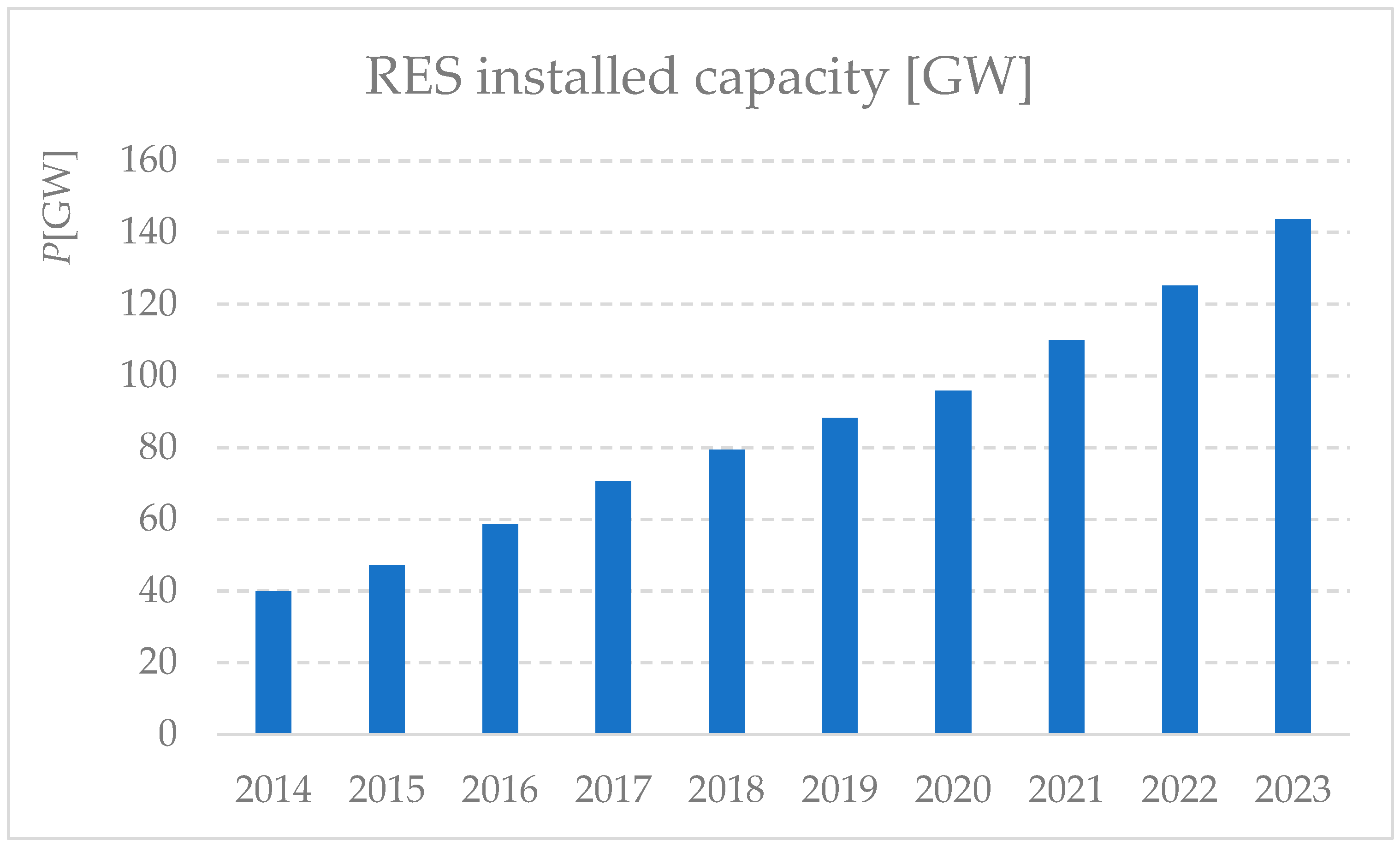

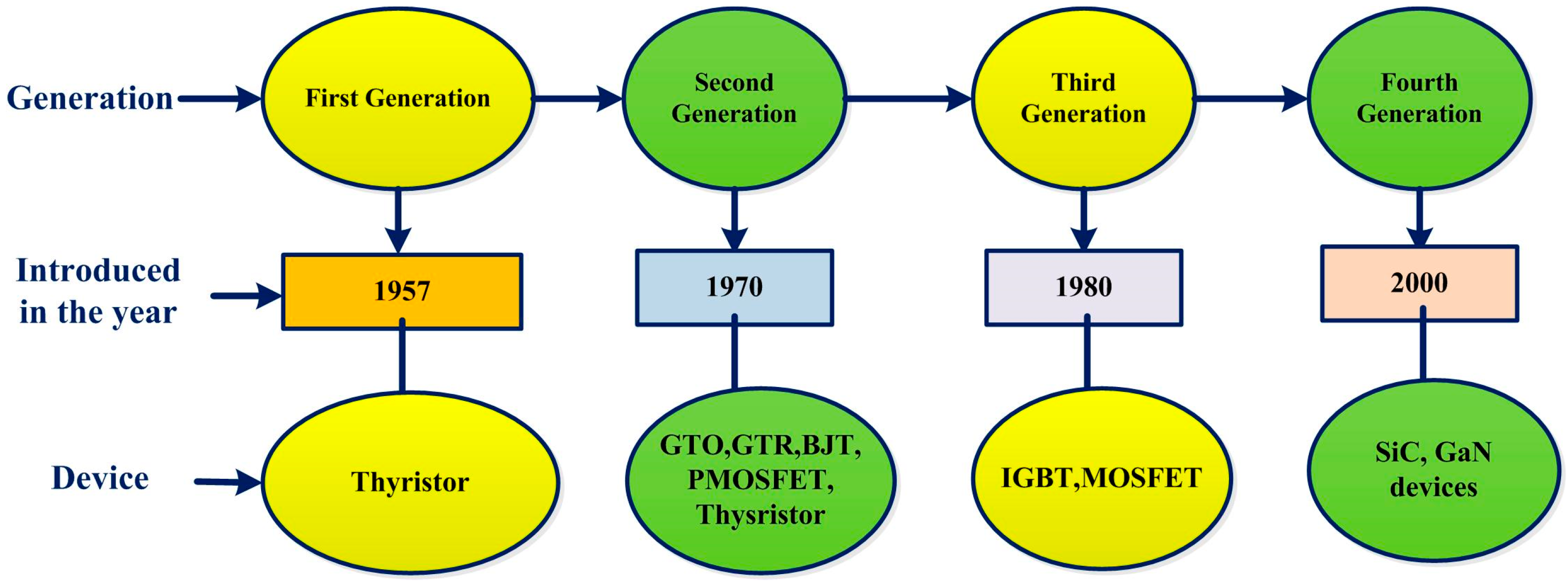

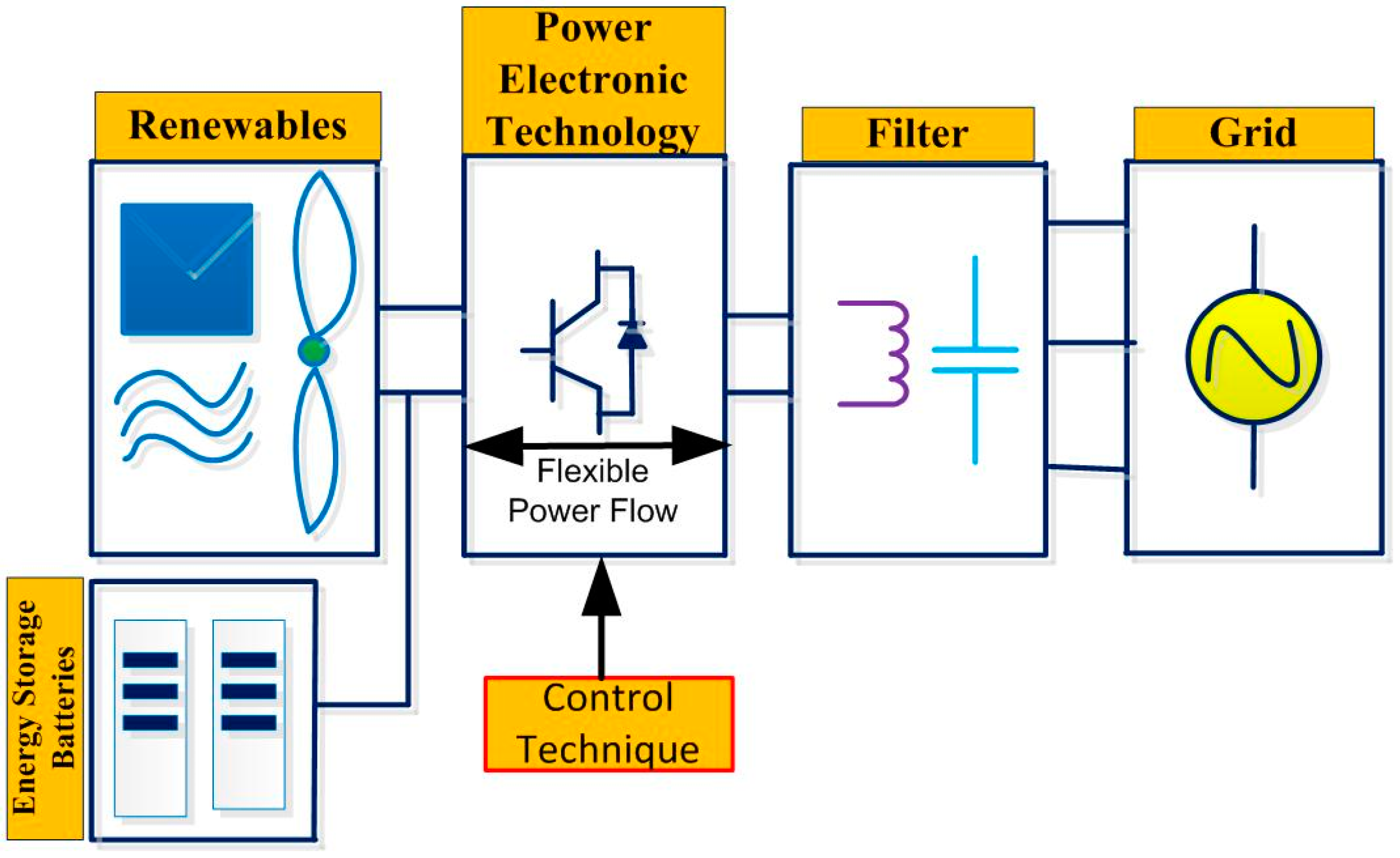
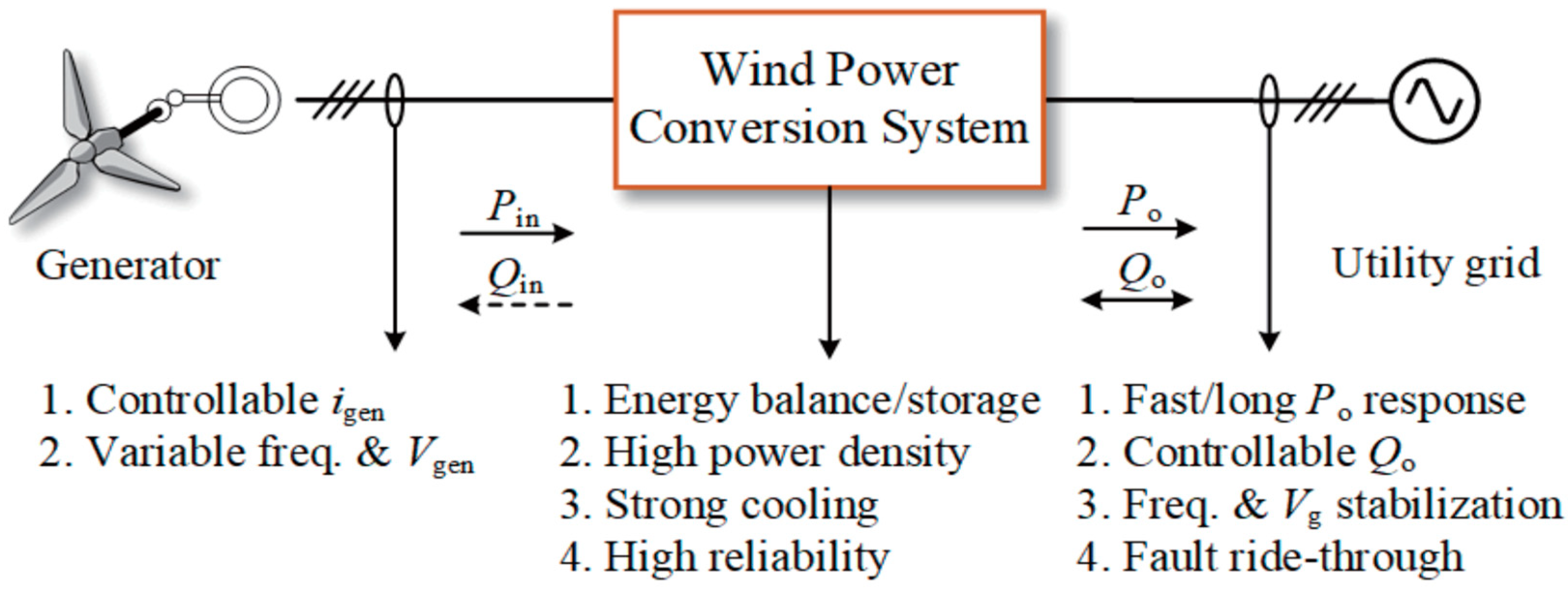
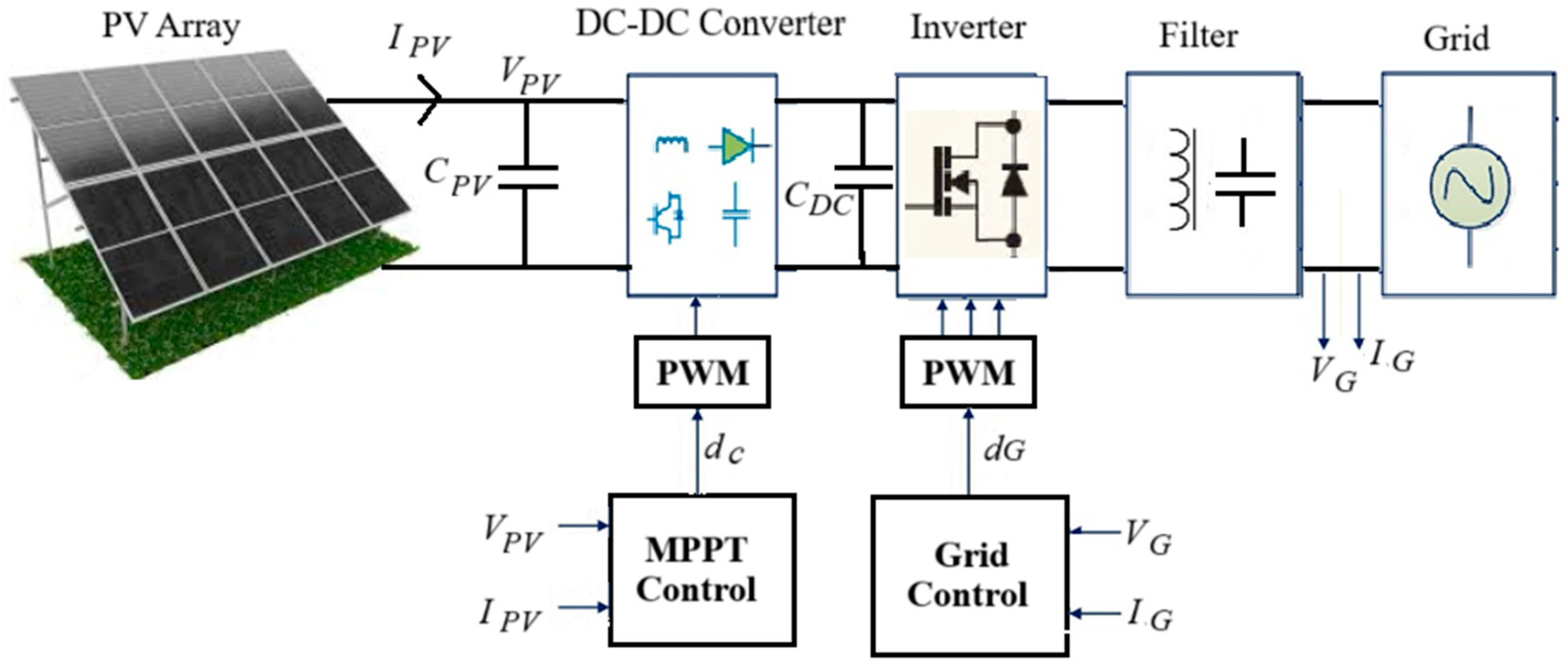


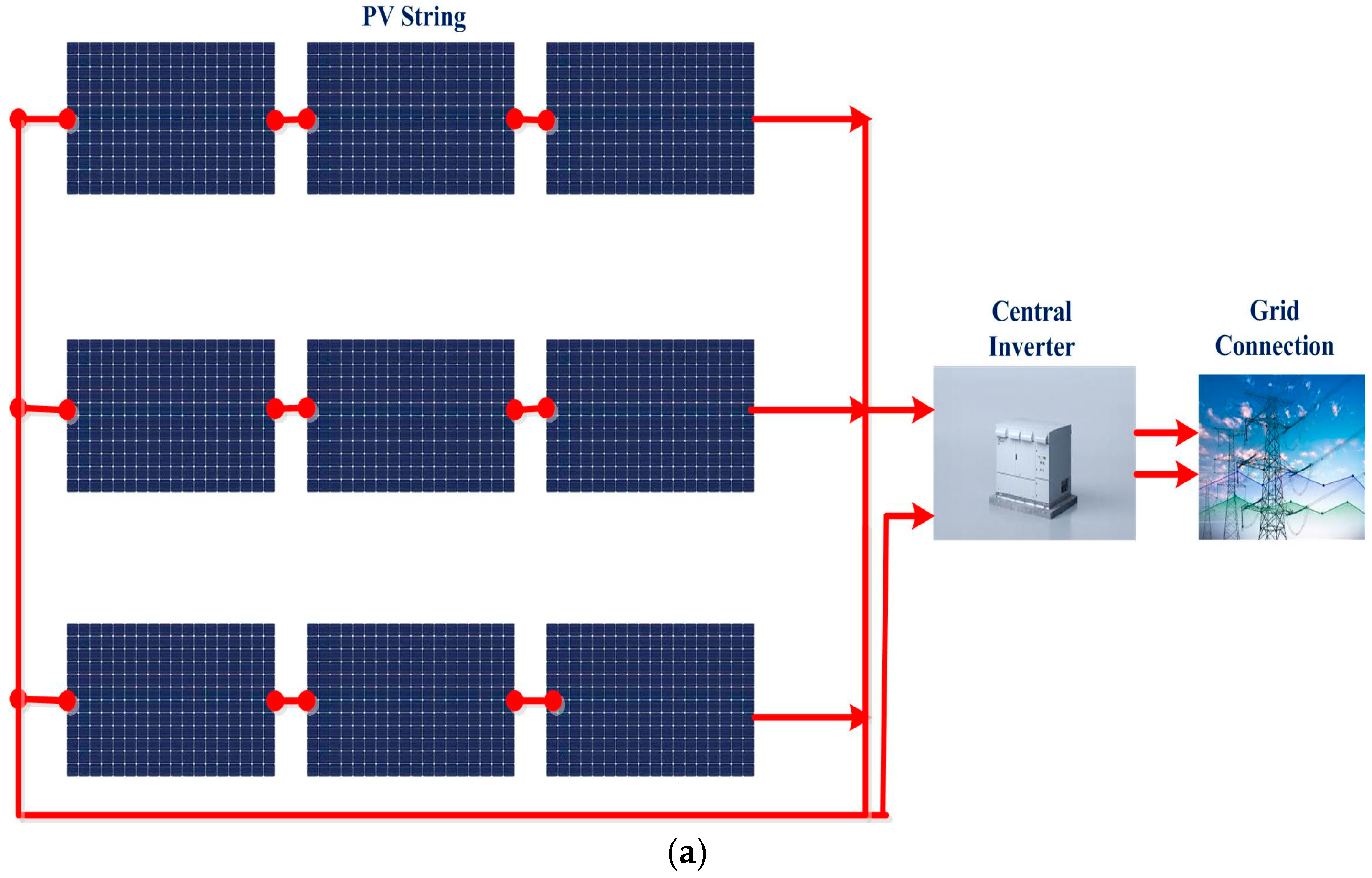





| Number of Literature Section | References | Area |
|---|---|---|
| (a) | [1,3,6,7,10,11,12,13,16,19,22,44,45] | Grid Integration and Stability of Renewable Energy Sources |
| (b) | [2,4,8,13,46,47,48,49,50,51,52,53,54,55] | Inverters and Power Electronics for Renewable Integration |
| (c) | [25,26,27,28,29,30,31,56,57,58] | MPPT Techniques for Solar PV Systems |
| (d) | [9,18,20,21,23,24,32,59,60,61,62,63,64] | Energy Storage Systems and Hybrid Configurations |
| (e) | [32,33,65,66,67,68,69,70,71] | Wind Energy Systems |
| (f) | [34,35,36,37,38,39,40,41,42,43] | Fuel Cell Power Systems |
| (g) | [15,17,53,72,73,74] | AI, Control, and Optimization in RE Systems |
| (h) | [14,75,76,77,78,79] | Control Techniques and Converter Design |
| Parameter | Central Inverter | String Inverter | Microinverter |
|---|---|---|---|
| Size of the system | Large | Medium | Small |
| Mode of installation | Single inverter for the entire power system | One inverter for group of panels | One inverter for each solar panel |
| Effect during faults | Low | Moderate | Very high |
| Initial cost | Low | Moderate | High |
| Impact of disturbance | Complete shutdown | One string may be affected | One panel may be affected |
| Reference Number | Author Details, Year of Publication | Proposed Work |
|---|---|---|
| [1] | Fache et al., 2025 | Policies for renewable energy in the United States |
| [3] | Ejuh Che et al., 2025 | Diverse constraints to integrating renewable energy |
| [6] | Ali et al., 2025 | Stability and high penetration of renewable energy |
| [10] | Wu et al., 2023 | Control and stability viewpoints in RESs |
| [11] | Alsokhiry, 2024 | Grid-connected hybrid systems |
| [12] | Liu et al., 2023 | Grid adaptability evaluation |
| [13] | Li and Zhang, 2023 | Dual-mode control for grid-following/forming |
| [22] | Li et al., 2020 | Capacity planning using SCR |
| [44] | Wang et al., 2023 | Multi-timescale inertia evaluation |
| [45] | Li et al., 2020 | Inertia damping in wind power integration |
| [19] | Rafiqi and Bhat, 2022 | Power quality using UPQC |
| [7] | Jain et al., 2022 | Grid-supportive loads |
| [16] | Mohammad et al., 2023 | Economic dispatch with renewables |
| [81] | Dobeissi et al., 2021 | RE potential in Lebanon |
| [2] | Gopal et al., 2025 | Switched-capacitor multilevel inverter |
| [4] | Gu et al., 2020 | Isolation for motor-generator pairs |
| [8] | Gopal et al., 2023 | Reduced device count inverter |
| [46] | Zhang et al., 2024 | Resonant circuit breaker |
| [47] | Amaral et al., 2024 | Capacitor failure diagnosis |
| [13] | Li and Zhang, 2023 | Dual-mode inverter control |
| [52] | Sangwongwanich et al., 2017 | Delta power control |
| [53] | Ouai et al., 2024 | Fault-tolerant converter |
| [54] | Mishra and Singh, 2021 | Four-phase SRM with three-level boost |
| [55] | Agorreta et al., 2009 | Fuzzy PWM converter |
| [50] | Chen et al., 2024 | Buck four-leg current inverter |
| [48] | Sun et al., 2018 | Split-capacitor inverter |
| [49] | Li et al., 2023 | A common-mode EMI analysis |
| [51] | Aamri et al., 2023 | DC link controller design |
| [56] | Katche et al., 2023 | Review of MPPT techniques |
| [57] | Bhukya et al., 2022 | Enhanced MPPT under shading |
| [25] | Basha and Rani, 2020 | Conventional vs. soft computing |
| [27] | Masry et al., 2023 | AI–traditional hybrid MPPT |
| [26] | Pandiyan et al., 2021 | MPPT in PV trees |
| [30] | Devarakonda et al., 2022 | A comparative analysis |
| [58] | Awan et al., 2023 | Ordering technique |
| [31] | Ko et al., 2020 | Overview in microgrids |
| [28] | Roy et al., 2024 | Deep learning with LSTM |
| [29] | Abidi et al., 2023 | Benchmarking MPPT techniques |
| [9] | Zhu et al., 2020 | Energy storage in VRE systems |
| [59] | Amir et al., 2023 | Energy storage review |
| [21] | Buduma et al., 2024 | PV + hybrid storage in a DC microgrid |
| [32] | Prince et al., 2024 | Wind + STATCOM + supercapacitor |
| [64] | Kinjo et al., 2006 | EDLC-based leveling |
| [20] | Deshmukh et al., 2023 | PV with battery integration |
| [60] | Montoya-Acevedo et al., 2024 | Hydrogen with a DC microgrid |
| [18] | Dalai et al., 2022 | DC microgrid management |
| [62] | Surulivel et al., 2024 | Four-port converter with common ground |
| [24] | Lin et al., 2024 | High-gain converter for RE |
| [63] | Rao and Sundaramoorthy, 2023 | Coupled cascaded boost |
| [23] | Karthikeyan et al., 2019 | High step-up DC–DC converter |
| [61] | Velasco-Quesada et al., 2009 | PV reconfiguration strategy |
| [65] | Hannan et al., 2023 | Wind energy review |
| [66] | Li et al., 2023 | Grid-side fault in DC wind system |
| [67] | Wang et al., 2011 | Small-scale grid-connected wind system |
| [68] | Blaabjerg and Ma, 2017 | Wind energy overview |
| [69] | Muljadi et al., 2007 | Weak grid stability |
| [70] | Amin and Mohammed, 2011 | Variable-speed wind utilization |
| [33] | Raza et al., 2024 | Fault handling in MMC HVDC wind system |
| [71] | Chinchilla et al., 2006 | PMG for variable-speed wind system |
| [34] | Jin et al., 2009 | Cold start in fuel cells |
| [35] | Lai and Ellis, 2017 | FC systems and applications |
| [36] | Emadi et al., 2006 | PE solutions for FC vehicles |
| [37] | Zhang et al., 2016 | Al–air FC in EVs |
| [38] | Cheng et al., 2012 | Interleaved converter |
| [39] | Wang and Li, 2010 | Fuel-economy-oriented control |
| [40] | Kirubakaran et al., 2011 | DSP control for DGs |
| [41] | Carreon-Bautista et al., 2015 | MPPT for microbial FC |
| [42] | Jin et al., 2009 | Hybrid fuel cell system |
| [43] | Wu et al., 2020 | High-gain converter in FC EVs |
| [72] | Sasikala et al., 2024 | AI in wind farm monitoring |
| [53] | Ouai et al., 2024 | Intelligent fault-tolerant PV converter |
| [15] | Wang et al., 2023 | Cuckoo search for an energy park |
| [17] | Houam et al., 2022 | Economic strategy for PV + battery system |
| [74] | Long et al., 2022 | Moth–flame optimization for control |
| [73] | Silva-Ortigoza et al., 2023 | Flatness-based control for DC motor |
| [14] | Li et al., 2022 | VSC-HVDC simulation |
| [75] | Sonti et al., 2019 | Open-circuit detection |
| [77] | Tseng et al., 2015 | Forward-flyback boost |
| [76] | Trinh et al., 2018 | Harmonic/DC current mitigation |
| [78] | Kuo et al., 2013 | IC design for energy harvesters |
| [79] | Dong et al., 2018 | Power-optimizer-fed inverter |
| Parameter | Area | Feature |
|---|---|---|
| Forecasting phenomenon | Solar and wind energy systems | Time series prediction analyses, weather forecasting, pattern recognition, etc. |
| Maximum power point tracking (MPPT) | Solar and wind energy systems | Harvesting maximum power from solar panels and wind turbines with the help of intelligent controllers |
| Monitoring | All RESs | Ensuring the system is free from cyber threats |
| Power quality | DGs connected to grid | Immediate detection of various power quality disturbances such as harmonics, interruptions, sags, swells, under- and over-voltage disturbances |
| Grid stabilization | DGs connected to grid | AI-powered devices ensure proper grid control and stability |
Disclaimer/Publisher’s Note: The statements, opinions and data contained in all publications are solely those of the individual author(s) and contributor(s) and not of MDPI and/or the editor(s). MDPI and/or the editor(s) disclaim responsibility for any injury to people or property resulting from any ideas, methods, instructions or products referred to in the content. |
© 2025 by the authors. Licensee MDPI, Basel, Switzerland. This article is an open access article distributed under the terms and conditions of the Creative Commons Attribution (CC BY) license (https://creativecommons.org/licenses/by/4.0/).
Share and Cite
Joddumahanthi, V.; Knypiński, Ł.; Gopal, Y.; Kasprzak, K. Review of Power Electronics Technologies in the Integration of Renewable Energy Systems. Appl. Sci. 2025, 15, 4523. https://doi.org/10.3390/app15084523
Joddumahanthi V, Knypiński Ł, Gopal Y, Kasprzak K. Review of Power Electronics Technologies in the Integration of Renewable Energy Systems. Applied Sciences. 2025; 15(8):4523. https://doi.org/10.3390/app15084523
Chicago/Turabian StyleJoddumahanthi, Vijaychandra, Łukasz Knypiński, Yatindra Gopal, and Kacper Kasprzak. 2025. "Review of Power Electronics Technologies in the Integration of Renewable Energy Systems" Applied Sciences 15, no. 8: 4523. https://doi.org/10.3390/app15084523
APA StyleJoddumahanthi, V., Knypiński, Ł., Gopal, Y., & Kasprzak, K. (2025). Review of Power Electronics Technologies in the Integration of Renewable Energy Systems. Applied Sciences, 15(8), 4523. https://doi.org/10.3390/app15084523






